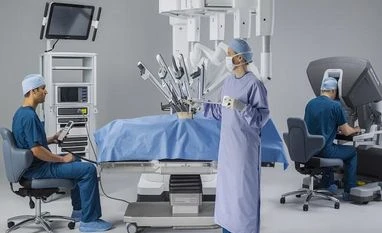What is that one thing patients are scared of while going through a surgery? Most would say, it is the pain associated with incisions that gives them the biggest scare, apart from the long recovery time. Even surgeons want their patients to heal and start leading normal lives as soon as possible.
Enter the da Vinci system, the world’s first FDA-approved robotic surgical procedure invented by California-based Intuitive Surgical, which reduces both the length of incision to about 1 cm and also the pain associated with it.
Hence, the time of healing goes down drastically. Intuitive Surgical has pulled robotic surgery out of the realm of science fiction and brought it to reality. The $3-billion company, which started direct operations in India last year, is already aiming to grow its procedures by 25-30 per cent every year.
“In India, we are at a nascent stage where our penetration is fairly limited, but that also defines the upside, as we can touch many more patients with this technology,” said Mandeep Singh Kumar, vice-president and general manager for India at Intuitive Surgical.
The US-based company is the world market leader in robotics surgery with no major competition from rivals. Currently, around 300 active surgeons in India are performing operations every quarter using the da Vinci system at hospitals such as Fortis, Apollo, Columbia Asia and Tata Memorial. Globally, the system has performed over six million successful surgeries so far.
How the system works
Unlike a normal laparoscopic instrument, the da Vinci system has endowrist instruments that can mimic human hand motion. In fact, the instruments have a larger range of motion than our hands. They can be rotated at angles of 180, 360 and 540 degrees. The surgeon console, where the doctor sits and makes all the movements, has two hand controls. During a surgery, the same hand movements get replicated inside the human body. The da Vinci system, which currently is running its fourth generation of robots, gives a 3D view of the body part to the surgeon. This 3D image can magnify up to 40 times. The surgeon console has sensors so the moment the doctor lifts his head out of the console, the hand controls stop moving to prevent any accidents.
The robot, which has five arms, gets attached to the human body through a long cannula that allows surgical instruments such as scalpels, sutures, and graspers to be used on the body part to be operated. In a typical laparoscopic surgery, the surgeon has two hands and an assistant holds the endoscopic camera. The surgeon makes the moves based on the feedback of the assistant, which can lead to accidents if the assistant is not alert. In the da Vinci system, the camera is mounted inside the body using one of the robot arms, so the chances of error are minimised. The doctor can make four or five holes as small as 1 cm in size in the patient's body, depending on the requirements of the surgery. Of this, one is used to attach the endoscopic camera. Of the other four, one could be used by an assistant to provide elements such as sutures and scissors to the surgeon. The head surgeon can control three robotic arms to perform the surgery with greater precision. In cases such as surgery of the gall bladder, the third arm could be used by the surgeon to safeguard the liver and then operate on the gall bladder using the other two arms. This is because the gall bladder lies just beneath the liver.
Also, the console provides a comfortable sitting position to the surgeon for long-duration surgeries. The system also has a technology called Firefly Imaging that enables real-time visual assessment of vessels, and blood flow with utmost precision.
The market for robotics surgery
The global robotic surgical market is growing at a compound annual growth rate (CAGR) of 10 per cent and is expected to reach $6.5 billion by 2023. The Indian market, however, is still small due to the high costs associated with the procedure.
Robotic surgeries have to be economically feasible not only for patients but also for hospitals. The third and fourth generation da Vinci systems currently being used in India cost $1 million and $2 million, respectively. Intuitive Surgical is not only investing in building its India team but also creating commercial finance capabilities to enable hospitals adopt to the da Vinci system.
“We are also investing in allied capabilities around clinical affairs related to how we utilise the clinical data that is getting produced in order to generate more society support,” said Kumar.
The company has so far set up about 70 systems and is training surgeons at the Amrita Institute of Medical Sciences and Research Centre, Kochi, and MS Ramaiah Medical College, Bengaluru. It also has its robots installed in two mobile vans that can travel to any part of the country to give a first-hand test drive to surgeons.
Another robotics firm, UK-based CMR Surgical, which recently raised $240 million in funding, is also gearing up to set up shop in India. Its next-generation surgical robotic system, Versius, could pose a threat to the da Vinci system. Also, medical giant Medtronic is expected to launch its surgical robots in the near future.
Intuitive Surgical has also rolled out a diagnostic product called ‘Ion’ to diagnose lung cancer using robotic technology. It enables the physician to extract a fine diagnostics sample to detect the disease. “Once we build more local capabilities, we will decide when to bring this product to India,” said Kumar.
Unlock 30+ premium stories daily hand-picked by our editors, across devices on browser and app.
Pick your 5 favourite companies, get a daily email with all news updates on them.
Full access to our intuitive epaper - clip, save, share articles from any device; newspaper archives from 2006.
Preferential invites to Business Standard events.
Curated newsletters on markets, personal finance, policy & politics, start-ups, technology, and more.
)